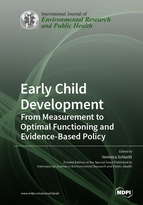Early Child Development: From Measurement to Optimal Functioning and Evidence-based Policy
A special issue of International Journal of Environmental Research and Public Health (ISSN 1660-4601). This special issue belongs to the section "Global Health".
Deadline for manuscript submissions: closed (25 December 2020) | Viewed by 59712
Special Issue Editor
Interests: Dr. Schiariti is a physician-scientist whose work bridges clinical research and international child health. For more than 10 years, she worked with children with developmental disabilities in community and tertiary-level rehabilitation centers as a developmental pediatrician. As a researcher, her primary interest has been promoting an abilities-oriented approach in assessments and evaluations of children and youths with neurodevelopmental disabilities, guided by WHO’s International Classification of Functioning, Disability, and Health (ICF)
Special Issue Information
Dear Colleagues,
In the early years of life, the environments that interact with a child—including families, schools, and communities—play a key role in the child’s brain development. Early child development and overall children’s developmental trajectories have long-term implications for health, happiness, and earning potential as these children become adults. Importantly, failing to reach developmental potential contributes to global cycles of poverty, inequality, and social exclusion. There is little public understanding of the importance of children’s first years and the critical developmental opportunity to reach optimal functioning. As such, global data on early child developments are crucial to inform the public and demand evidence-based policies and high-quality programs for children around the world.
This Special Issue seeks papers on early child development, including those on assessing the impact of programs and interventions related to children’s health, education, and participation that could inform evidence-based policies around the world. International representation of studies is highly sought. Methodological and implementation studies will be considered. High-quality narrative and systematic reviews will also be considered.
Dr. Verónica Schiariti
Guest Editor
Manuscript Submission Information
Manuscripts should be submitted online at www.mdpi.com by registering and logging in to this website. Once you are registered, click here to go to the submission form. Manuscripts can be submitted until the deadline. All submissions that pass pre-check are peer-reviewed. Accepted papers will be published continuously in the journal (as soon as accepted) and will be listed together on the special issue website. Research articles, review articles as well as short communications are invited. For planned papers, a title and short abstract (about 100 words) can be sent to the Editorial Office for announcement on this website.
Submitted manuscripts should not have been published previously, nor be under consideration for publication elsewhere (except conference proceedings papers). All manuscripts are thoroughly refereed through a single-blind peer-review process. A guide for authors and other relevant information for submission of manuscripts is available on the Instructions for Authors page. International Journal of Environmental Research and Public Health is an international peer-reviewed open access monthly journal published by MDPI.
Please visit the Instructions for Authors page before submitting a manuscript. The Article Processing Charge (APC) for publication in this open access journal is 2500 CHF (Swiss Francs). Submitted papers should be well formatted and use good English. Authors may use MDPI's English editing service prior to publication or during author revisions.
Keywords
- Child development
- Child health
- Functioning
- International Classification of Functioning, Disability, and Health
- Outcomes
- Participation
- Social inclusion
- Children rights
- Education
- Social services
- Measurement
- Functional indicators
- Screening
- Surveillance
- Environmental interventions
- Empowerment
- Equality
- Evidence-based policy






